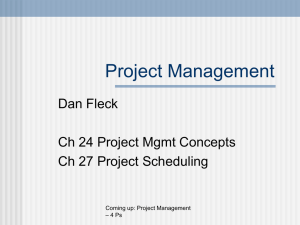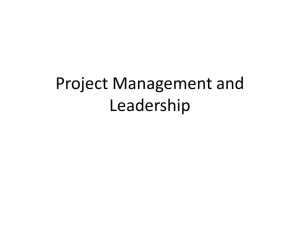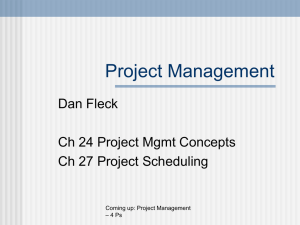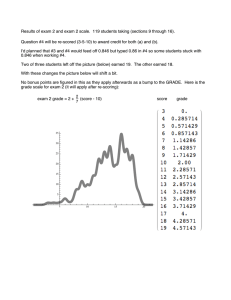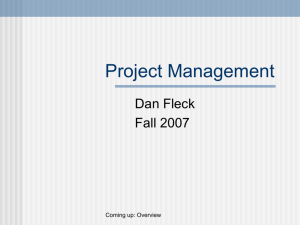Project Management Dan Fleck Fall 2009 Ch 24 Project Mgmt Concepts
advertisement
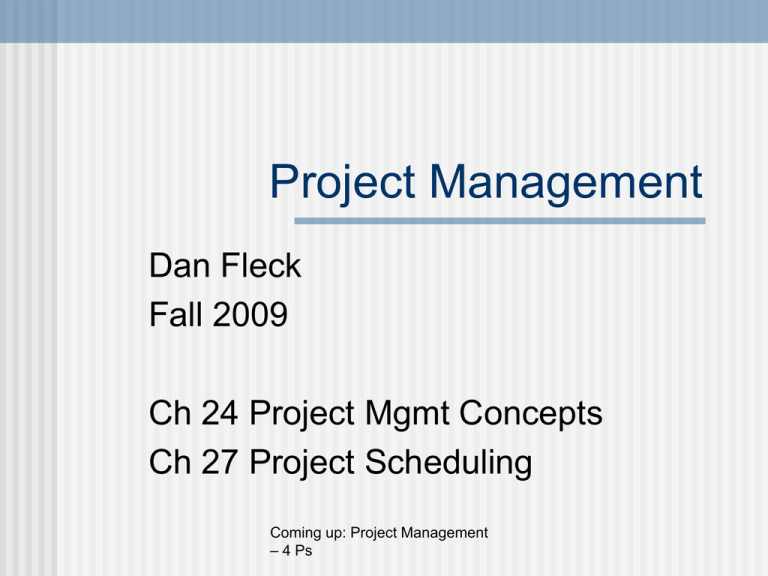
Project Management Dan Fleck Fall 2009 Ch 24 Project Mgmt Concepts Ch 27 Project Scheduling Coming up: Project Management – 4 Ps Project Management – 4 Ps People — the most important element of a successful project Product — the software to be built Process — the set of framework activities and software engineering tasks to get the job done Project — all work required to make the product a reality Coming up: Stakeholders are people to Stakeholders are people to Senior managers who define the business issues that often have significant influence on the project. Project (technical) managers who must plan, motivate, organize, and control the practitioners who do software work. Practitioners who deliver the technical skills that are necessary to engineer a product or application. Customers who specify the requirements for the software to be engineered and other stakeholders who have a peripheral interest in the outcome. End-users who interact with the software once it is released for production use. Your job is to organize and bring value from these people Coming up: Your job as a leader Your job as a leader The MOI Model Motivation. The ability to encourage (by “push or pull”) technical people to produce to their best ability. Organization. The ability to mold existing processes (or invent new ones) that will enable the initial concept to be translated into a final product. Ideas or innovation. The ability to encourage people to create and feel creative even when they must work within bounds established for a particular software product or application. Coming up: Your job as a manager Your job as a manager Make sure these happen Formal risk management Empirical cost and schedule estimation Metrics-based project management Tracking – amount of work done, costs, work remaining, etc… Defect tracking against quality targets People aware project management Coming up: Project Manager Project Manager Management is using tools and techniques Leadership is inspiring people to do the right thing Leadership with poor management practices can be successful, management with poor leadership will fail. Coming up: Motivating People Motivating People Use monetary rewards cautiously Use intrinsic rewards Recognition Achievement The work itself Responsibility Advancement Chance to learn new skills Coming up: Understanding the problem Understanding the problem At the beginning you should ask yourself these questions Why is the system being developed? What will be done? When will it be accomplished? Who is responsible? Where are they organizationally located? How will the job be done technically and managerially? How much of each resource (e.g., people, software, tools, database) will be needed? Barry Boehm Coming up: Define success and failure Define success and failure Don’t lie to yourself! Be confident, trust yourself for success! Quantify your project outcomes to allow success or failure A vague or un-measurable outcome is much less helpful - Dan Fleck Coming up: Leadership Case Study: 3M Leadership Case Study: 3M Philosophy: As our business grows, it becomes increasingly necessary to delegate responsibility and to encourage men and women to exercise their initiative. This requires considerable tolerance. Those men and women to whom we delegate authority and responsibility, if they are good people, are going to want to do their jobs in their own way. "Mistakes will be made. But if a person is essentially right, the mistakes he or she makes are not as serious in the long run as the mistakes management will make if it undertakes to tell those in authority exactly how they must do their jobs.” "Management that is destructively critical when mistakes are made kills initiative. And it's essential that we have many people with initiative if we are to continue to grow." . These are common themes now, but not in 1940s when 3M codified them Coming up: 3M Results 3M Results Encouragement and a culture of innovation yields: 1968 Dr. Spence Silver does an experiment that yields an adhesive that sticks, but not strongly Presents around the company for 5 years with no “takers” In 1973, 3M scientist Art Fry was trying to mark his place in his church choir hymn book with bits of paper that kept falling out. As he did so Art works with Spence. Creates little notepapers. Marketing says “not enough market, who wants to pay for scraps of paper?”, engineering says “too hard to make, will be costly” Response: If it’s hard to make that’s great, no one but 3M will be able to do it! Fry sends out “free samples” across the company, making sure to include executive’s assistants Demand rises – finally the product is introduced. Within 1 year PostIt notes named “Outstanding New Product” and today generates $100 million in US sales This is possible because of a culture in the company to empower, encourage, and experiment! Coming up: Avoid team toxicity Avoid team toxicity A frenzied work atmosphere in which team members waste energy and lose focus on the objectives of the work to be performed. High frustration caused by personal, business, or technological factors that cause friction among team members. “Fragmented or poorly coordinated procedures” or a poorly defined or improperly chosen process model that becomes a roadblock to accomplishment. Unclear definition of roles resulting in a lack of accountability and resultant finger-pointing. “Continuous and repeated exposure to failure” that leads to a loss of confidence and a lowering of morale. Coming up: Scheduling Scheduling One of the most important things you can do is schedule. Also one of the first things you should do! Tools help Microsoft Project OpenProj.org <-- This is what I will use OpenWorkbench.org Find another good one? Let me know… there are web-based tools out there also. Coming up: Planning Planning The bad news: time flies The good news: you’re the pilot! You must begin planning immediately Given limited information Plan anyway and then revise Coming up: Creating a plan: Things to know Creating a plan: Things to know Scope • Context. How does the software to be built fit into a larger system, product, or business context and what constraints are imposed as a result of the context? • Information objectives. What customer-visible data objects (Chapter 8) are produced as output from the software? What data objects are required for input? • Function and performance. What function does the software perform to transform input data into output? Are any special performance characteristics to be addressed? Software project scope must be unambiguous and understandable at the management and technical levels. Coming up: Creating a plan: Things to do Creating a plan: Things to do Problem Decomposition: Sometimes called partitioning or problem elaboration Once scope is defined … It is decomposed into constituent functions It is decomposed into user-visible data objects or It is decomposed into a set of problem classes Decomposition process continues until all functions or problem classes have been defined (this won’t be far at the beginning of your project) Coming up: Create a schedule Create a schedule An idea without a schedule is just a dream. - Unknown Coming up: Schedule Schedule List of tasks With dates With assigned resources (people) With durations With predecessors and successors How do you get buy-in from the team for a schedule? Coming up: Schedule Terms Schedule Terms Critical path Sequence of tasks that form the longest path to completion of the project. Any delay on any of these will make the overall completion date move. Slack Amount of time a task can be delayed without affecting the overall completion date. • Start slack - amount before task needs to start • Finish slack - amount before task needs to finish Milestone - An import date in the schedule Dependencies - relationship between tasks Coming up: Schedule Dependencies Schedule Dependencies FS - Finish to start (most common) FF - Finish to finish A FF B. B doesn’t finish before A is finished Write final chapter FF Complete Index SS - Start to start A FS B. B doesn’t start until A is finished Build wall FS Paint wall A SS B. B doesn’t start until A has started Project funded SS project management activities begin SF - Start to finish A SF B. B doesn’t finish before A has started Once A starts, B is allowed to finish B=Baby sit a child, A=parent comes home Coming up: Resource Leveling Resource Leveling A process to examine a project for an unbalanced use of people and to resolve over-allocations or conflicts Happens when multiple tasks are scheduled at the same time for the same person Solution: Make tasks sequential Split resource usage among tasks (50% on task 1, 50% on task 2) See example: NeedToLevel.pod Coming up: Auto Resource Leveling Auto Resource Leveling Some tools (not Open Project) provide auto resource leveling Tool automatically ensures no person works over 100% of the time (automatically makes tasks sequential) Advantageous because this does not introduce “fake” dependencies Coming up: Gantt Chart Gantt Chart Coming up: Finding Critical Path Finding Critical Path Draw a network diagram of the activities Determine the Early Start (ES) of each node. Work from beginning node (ES=0) to final node ES - earliest time the activity can start ES = Max(ESprevNode + DurationPrevNode) ES: 4 A ES: 2 B Coming up: Finding Critical Path ES: ?? C Finding Critical Path Determine the Late Start (LS) of each node. Work from the final node to the beginning node. The latest time the activity can start without changing the end date of the project LS = MIN(LSnext - DurationNode) LS: 13 For the last node LS = ES B LS: ? A LS: ? Coming up: Example B LS: 12 C LS: ? A LS: 12 C Example Here's the example: Activity Description A Product design B Market research C Production analysis D Product model E Sales brochure F Cost analysis G Product testing H Sales training I Pricing J Project report Coming up: Example Node Network Predecessor (None) (None) A A A C D B, E H F, G, I Duration 5 months 1 2 3 2 3 4 2 1 1 Example Node Network ES:5 ES(H) LS: ES(E)+dur(E) = 5 + 2C= 7 ES(J) ES:0 LS: ES(B)+dur(B) 1=1 ES(F)+dur(F) ==? 0 +ES:5 A= 7 ==ES(H) Maximum ES(G)+dur(G) ? LS: D ES(I) + dur(I) = ? ES:0 ES:5 LS: Maximum = ? = ES(J) LS: B E ES:7 LS: F ES:12 LS: G J ES:8 LS: I ES:9 LS: H ES:7 LS: Coming up: Example Node Network Here's the example: Activity A B C D E F G H I J Description Predecessor Product design (None) Market research(None) Production A Product model A Sales brochure A Cost analysis C Product testing D Sales training B, E Pricing H Project report F, G, I Duration 5 months 1 2 3 2 3 4 2 1 1 LS(A) = LS(C) – dur(A) = 7 – 5 = 2 LS(D) – dur(A) = 5 – 5 = 0 LS(E) – dur (A) = 7 – 5 = 2 Minimum = 0 = LS(A) Example Node Network ES:5 LS:7 ES:0 LS:0 A ES:7 LS:9 C F ES:12 LS:12 ES:5 LS:5 G D ES:0 LS:8 B J ES:8 LS:8 ES:5 LS:7 E I ES:9 LS:11 LS(F) LS(J)-dur(F) = 12 – 3 =9 Coming up: Example Node Network H ES:7 LS:9 Here's the example: Activity A B C D E F G H I J Description Predecessor Product design (None) Market research(None) Production A Product model A Sales brochure A Cost analysis C Product testing D Sales training B, E Pricing H Project report F, G, I Duration 5 months 1 2 3 2 3 4 2 1 1 Example Node Network ES:5 LS:7 ES:0 LS:0 A ES:7 LS:9 C F ES:12 LS:12 ES:5 LS:5 G D ES:0 LS:8 B J ES:8 LS:8 ES:5 LS:7 E I ES:9 LS:11 H ES:7 LS:9 Coming up: Game Development In-Class Exercise Here's the example: Activity A B C D E F G H I J Description Predecessor Product design (None) Market research(None) Production A Product model A Sales brochure A Cost analysis C Product testing D Sales training B, E Pricing H Project report F, G, I Duration 5 months 1 2 3 2 3 4 2 1 1 Game Development In-Class Exercise Find the critical path TASK DURATION (days) A Graphics Engine 14 B Sound Engine 5 I C Music Engine 5 J D Input Engine 10 A E Gameplay/general programming 31 B, C, D F Physics 7 E G 2D Artwork 14 H 3D Artwork 21 I Sound Effects 14 J Music 9 K Level Design 21 Coming up: Review Questions PREDECESSORs G F, H Review Questions What is the critical path? Do all nodes on the critical path have to be connected to each other? (directly) What is slack? When should you write your schedule for the work? What is resource leveling? Coming up: What about Agile? What about Agile? Planning and tracking is still important! Scrum Burndown Chart Release Burndown: Number of story points versus Release Sprint Burndown: Number of story points versus day Burndown chart shows amount of work remaining, and charts the trajectory to help predict success or failure Coming up: Sprint Burndown Chart Story Points Remaining Sprint Burndown Chart Day Coming up: Release Burndown Chart Story Points Remaining Release Burndown Chart Iteration Number Coming up: Burndown Chart Burndown Chart Vertical axis can be any metric describing amount of work remaining: Story points User Stories Use Cases Requirements Ideal developer hours Coming up: Earned Value Management Earned Value Management How much work you planned to have accomplished by now (in dollars or hours) called the Planned Value How much you have actually spent by now (in dollars or hours), called Actual Cost The value, in terms of your baseline budget, of the work accomplished by now (in dollars or hours), called the Earned Value! Coming up: Earned Value Management Earned Value Management Planned value (PV) - the value of all resources needed to meet the project’s objectives Each objective of a project has an associated planned value Budgeted (cost) at completion (BAC) - The sum of all the PVs Earned value (EV) - the amount of value completed at any point during the project Actual Cost (AC) - actual amount of money you have spent so far. In a perfect project AC and EV are the same. Coming up: Earned Value Management Example Earned Value Management Example We’ve budgeted $200 to buy, setup, network and test a new system Our planned values (PVs) of each task are: • Buy - $50, Setup - $75, network - $50, test - $25 • Our BAC is therefore $200 We’ve now completed phase one, and thus our earned value (EV) is now $50. To do this we spent $60 (our actual cost (AC)) Coming up: Earned Value Management Example Earned Value Management Example Schedule performance index (SPI) Cost performance index (CPI) Memorization Hint: Most equations begin with earned value EV / AC --> 50/60 = 0.83 For every dollar spent, I get 83 cents worth of work. Estimated cost at completion (EAC) EV / PV --> 50/50 = 1 (perfect). Our group is on schedule BAC / CPI = 200 / 0.83 = $240.96 Schedule Variance (SV) : EV - PV Cost Variance (CV) : EV - AC Coming up: EVM Example 2 from: http://www.hyperthot.com/pm_cscs.htm EVM Example 2 from: http://www.hyperthot.com/pm_cscs.htm Line is at 16, blue bar ends at 14 Line is at 6 PLANNED VALUE (Budgeted cost of the work scheduled) = 18 + 10 is + 16 + 6 = $50 What planned value at time X? EARNED VALUE (Budgeted cost of the work performed) = 18 + 8 + 14 + 0 = $40 What is earned value at time X? ACTUAL COST (of the work performed) = $45 (Data from Acct. System) Therefore: Schedule Variance = 40 - 50 = -$10 Earned – Planned. Schedule Performance Index = 40 / 50 = 0.8 Coming up: What is earned value? Perfect is? What is earned value? A. The amount of money you get upon completion of a task B. The value of an activity C. The value of the work completed by now in the schedule D. The value of all activities planned to be completed by now in the schedule Coming up: Why do you use earned value management? Why do you use earned value management? A.It is required by my contract B. Measuring value give you more information than measuring cost or time alone C. I don’t use it D. It guarantees my project will be done on time Coming up: Scheduling Rules of Thumb Scheduling Rules of Thumb Don’t work backwards! One person should always edit the schedule (you!) If you have two people that need to, create two files and link them together Keep it simple and useful Level your resources Share the schedule with your team Coming up: Schedule Example Schedule Example Lets try to schedule this work among our three developers “John, Mary, Carl” TASK DURATION (days) A Graphics Engine 14 B Sound Engine 5 I C Music Engine 5 J D Input Engine 10 A E Gameplay/general programming 31 B, C, D F Physics 7 E G 2D Artwork 14 H 3D Artwork 21 I Sound Effects 14 J Music 9 K Level Design 21 Coming up: Scheduling Steps PREDECESSORs G F, H Scheduling Steps Add in all the tasks (preferably in a hierarchy) Add in all the dependencies Break down large tasks into smaller tasks. Optimally (in Dan Fleck’s opinion) you want to schedule so the duration of each smallest task is at most 3-5 days Assign people (resources) to tasks Level your resources Coming up: Classic Mistakes Classic Mistakes Overly optimistic schedule Failing to monitor schedule Failing to update schedule Adding people to a late project Failure to manage expectations of others Leaving out a task Coming up: Scope Creep BOO! Scope Creep Scope The scope of your project is all the work you initially planned to do. Scope creep is when your project gets new tasks throughout it’s lifetime without adding more resources to handle new tasks. The scope is “creeping” up… Scope changes are OK, and really unavoidable… that’s fine. However you must update the resources (time, features or people accordingly) Coming up: Why would scope changes occur? Why would scope changes occur? A. You get more money to do more things B. The customer asks you to do something extra because “it is critical for success” C. A competing product has a feature that you must have to be competitive D. All of these Coming up: Which are causes of scope creep? Scope Change versus Creep Change is good! Your company has a $1million dollar contract with a defined scope. Scope change: Customer: please add all these requirements, and I’ll increase the contract to $2million dollars Manager: Certainly! Scope creep: Customer: please add all these requirements, and I’ll be really happy. Manager: Certainly! Which are causes of scope creep? A. poor change control B. lack of proper initial identification of what is required to satisfy project objectives C. a weak project manager D. all of these Source: Wikipedia: Scope Creep Coming up: Managing Scope Managing Scope How to deal with the inevitable “Scope creep”? JAD and prototyping Scope Formal change approval Defer additional requirements as future system enhancements Coming up: Managing Risk Common-Sense Approach to Projects Start on the right foot. This is accomplished by working hard (very hard) to understand the problem that is to be solved and then setting realistic objectives and expectations. Maintain momentum. The project manager must provide incentives to keep turnover of personnel to an absolute minimum, the team should emphasize quality in every task it performs, and senior management should do everything possible to stay out of the team’s way. Track progress. For a software project, progress is tracked as work products (e.g., models, source code, sets of test cases) are produced and approved (using formal technical reviews) as part of a quality assurance activity. Make smart decisions. In essence, the decisions of the project manager and the software team should be to “keep it simple.” Conduct a postmortem analysis. Establish a consistent mechanism for extracting lessons learned for each project. Coming up: References References www.projity.com Wikipedia: Project Management Pressman R., Software Engineering A Practical Approach, Ch 21 Pressman R., Software Engineering A Practical Approach, Slides for Ch 21 Kazman R., The CIO, People Issues, Project & Change Management, kazman.shidler.hawaii.edu/619ch12.ppt Pratt M, Earned Value Management, http://www.computerworld.com/action/article.do?command=viewArticleBasic&articleI d=110065&intsrc=article_pots_bot End of presentation
